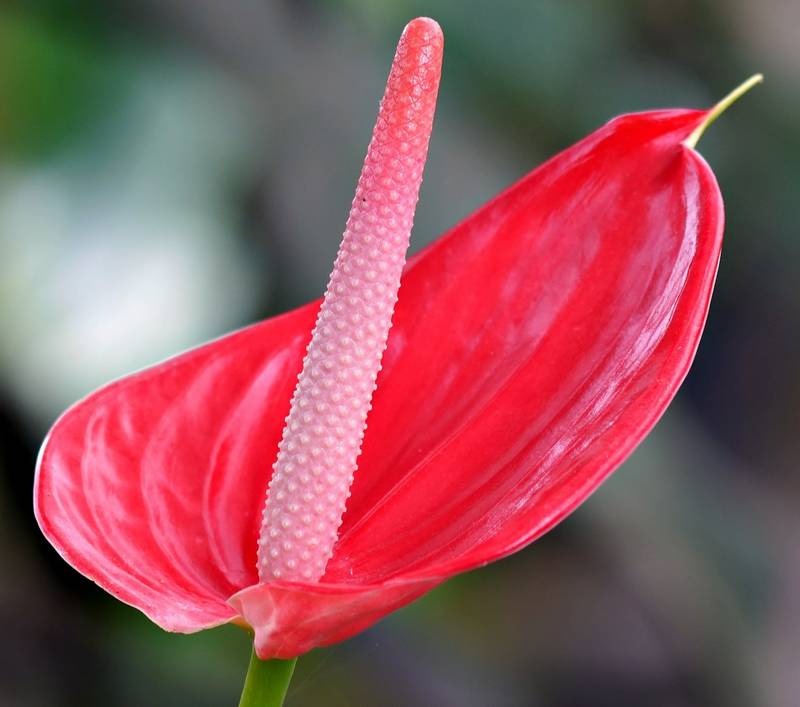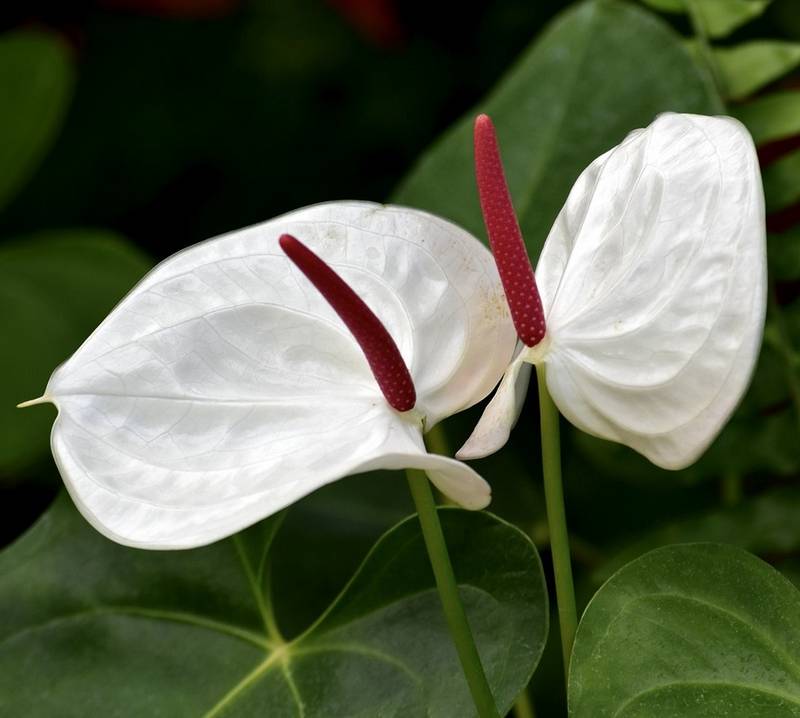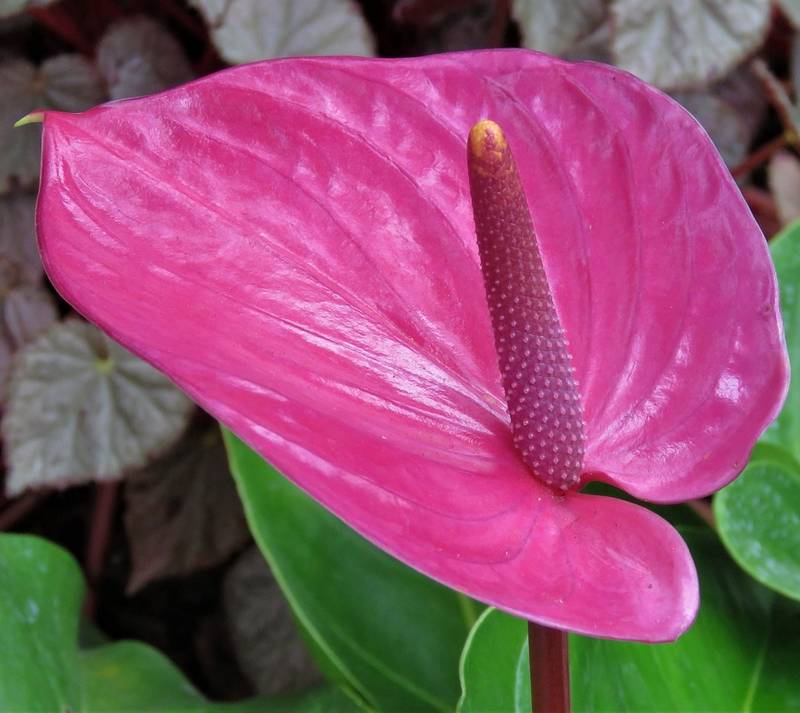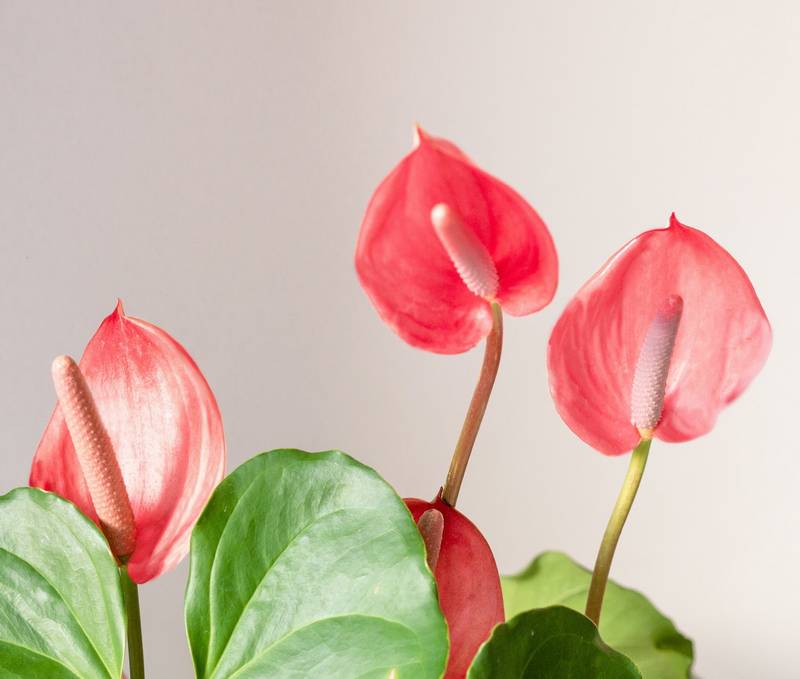Are Anthurium Toxic to Dogs? Are Anthurium Poisonous to Dogs?
Are Anthurium toxic to dogs? Are Anthurium poisonous to dogs? In this article, we’ll explain all you need to know about if Anthurium are safe for dogs, including what to do if your dog ate Anthurium already. We’ll then cover the two commands that will ensure your dog behaves around Anthurium and other plants that might be toxic.
Next, we’ll teach you more you should know about Anthurium and dogs, such as how to keep dogs away from Anthurium using barriers. Finally, we’ll instruct you on the proper care of Anthurium plants (varieties, soil mix, repotting, problems, potting mix, lifespan, hardiness zone, sun or shade) and more to know when you have dogs. Keep reading!
Are Anthurium Toxic to Dogs?

Anthurium are toxic to dogs. If ingested, they can cause symptoms such as vomiting, excessive drooling, and oral irritation. It’s important to train your dog to avoid these plants and to know what steps to take if poisoning occurs.
Are Anthurium Poisonous to Dogs?
Anthurium are poisonous to dogs. The plant contains insoluble calcium oxalate crystals which can cause various symptoms, including difficulty swallowing, vomiting, and excessive drooling. Immediate action should be taken if your pet ingests any part of an Anthurium plant.
Anthurium Poisoning in Dogs Symptoms
Symptoms of Anthurium poisoning in dogs include but are not limited to vomiting, excessive drooling, and oral irritation. If your dog is pawing at its mouth, this may be an indication that something is amiss.
Other symptoms could include difficulty swallowing and gastrointestinal upset. In severe cases, a veterinarian’s intervention may be required for diagnosis and treatment.
Train the “Leave It” Command
- Start with a less appealing item in one hand and treats in the other.
- Open your hand with the less appealing item and say “leave it.”
- When the dog ignores the item and turns its attention to you, give a treat and praise.
- Gradually increase the difficulty by using more appealing items.
- Practice this daily to reinforce the behavior.
Training your dog to understand the “leave it” command can be a valuable tool in preventing them from ingesting toxic plants like Anthurium. With consistent training, your dog can learn to ignore these harmful plants, thus reducing the risk of poisoning.
Train the “Drop It” Command
- Start by playing a game of tug with a toy.
- During the game, say “drop it” and offer a treat in exchange for the toy.
- When the dog releases the toy, immediately give the treat and verbal praise.
- Repeat this sequence multiple times during different play sessions.
- Regularly practice this command to make it a habit for the dog.
Just like the “leave it” command, the “drop it” command can be crucial if your dog ever picks up a piece of Anthurium. In such cases, a well-timed “drop it” can mean the difference between a close call and a trip to the veterinarian.
Anthurium are toxic to dogs and can cause a range of symptoms including vomiting and oral irritation. These commands will help keep your dog safe, but it’s important to remember that the underlying behavioral issues (curiosity, anxiety, boredom, etc.) that were causing all of this to begin with will still be present.
And until you address those, any positive changes you see are only going to be temporary.
“Well, how do I make these changes last?”
By getting your dog to truly choose to follow your direction, that’s how. I tried many times to write out how you can do that before deciding it made more sense to just link you to the free video series that explains it better than I’d ever be able to.
The series is by a man named Dan who is one of the world’s leading dog obedience trainers. In it, he teaches you how to put an end to things like your dog getting too close to Anthurium and all other misbehavior using his fast and easy-to-follow methods.
In the first video, Dan will reveal to you why the two most common methods of dog training only doom you to failure. You can watch the video now by clicking here. Follow the proven system he’ll show you in his series and you’ll never have to spend another second worrying about your dog eating Anthurium flowers ever again!
Are Anthurium Safe for Dogs?

Anthurium are not safe for dogs. Ingesting the plant can lead to symptoms such as vomiting, oral irritation, and excessive drooling. It’s important to be proactive in preventing your dog from accessing these plants and knowing what steps to take if they do ingest Anthurium.
What to Do if Your Dog Eats Anthurium
If your dog eats Anthurium, immediate action is necessary. Begin by removing any plant material from your dog’s mouth, if possible. Next, you should monitor for symptoms such as vomiting, excessive drooling, or oral irritation.
Call your veterinarian as soon as you notice these symptoms for advice on the best course of action. Depending on the severity, your veterinarian may suggest that you bring your dog in for treatment, which may include induced vomiting or intravenous fluids.
Dog Eating Anthurium: How to Prevent
Preventing your dog from eating Anthurium involves a few strategic steps. First, consider placing the plant in an area that is out of your dog’s reach, like a high shelf or behind a barrier. You could also consider using deterrent sprays on the plant leaves, which are designed to discourage dogs from chewing.
Another option is to train your dog to stay away from specific areas where the plants are located, using positive reinforcement techniques like treats and praise when they obey. Learn two of the most important commands to know by going back to the first section now.
You should get this handled as soon as possible, as doing so will also help keep your dog safe around all other plants. You then won’t have to stress about things like are Black Eyed Susans toxic to dogs, is Barberry toxic to dogs, is Ninebark toxic to dogs, or is delphinium poisonous to dogs.
Why Are Dogs Attracted to Anthurium?
Dogs may be attracted to Anthurium for various reasons. Some dogs are naturally curious and may be drawn to the plant’s bright colors or unique textures. In other cases, dogs may be attracted by the smell, especially if the plant is flowering. It’s not entirely understood why some dogs choose to eat plants, but it’s crucial to recognize this behavior and take appropriate preventative steps.
In summary, Anthurium are not safe for dogs and should be kept out of their reach. If your dog does eat Anthurium, quick action and a visit to the veterinarian may be required. Understanding why your dog might be attracted to these plants can help you take preventative measures to keep them safe.
Anthurium and Dogs

Anthurium and dogs are a bad combination. Though strikingly beautiful, Anthurium are toxic to dogs and can cause symptoms like vomiting and oral irritation if ingested. To ensure the safety of your furry friend, you should take preventive measures such as creating barriers or opting for dog-safe plant alternatives.
How to Keep Dogs Away From Anthurium
Keeping your dog away from Anthurium can be achieved through several methods. Barriers like fencing or indoor gates can effectively restrict access to areas where these plants are located. You may also place the Anthurium on high shelves or hanging pots that are out of your dog’s reach.
Additionally, consider using pet deterrent sprays that are designed to keep dogs away from treated areas. Training them on commands like “Leave It” and “Drop It” is also incredibly helpful for keeping your dog safe. Learn both now in the first section.
Dog-Safe Alternatives to Anthurium
If you want to keep your home or garden aesthetically pleasing without risking your dog’s health, consider switching to dog-safe plants. Some good alternatives include asters, spider plants, or marigolds. These plants are not toxic to dogs and will be a safer choice.
Why Should Dogs Not Eat Flowers?
Even if a flower or plant is non-toxic, it’s generally not a good idea for dogs to eat them. Plants can carry pesticides or harmful bacteria that can lead to digestive upset. Additionally, eating plants may be a sign of dietary deficiencies or boredom, which should be addressed through proper diet and mental stimulation.
In summary, Anthurium are not safe for dogs and can lead to adverse symptoms if ingested. Use barriers or choose dog-safe plants to minimize risks. Furthermore, educate those in your household to ensure the safety of your pet.
Anthuriums Care

Anthurium plants, also known as Laceleaf, require specific care involving well-drained soil, moderate light, and regular watering. They come in various varieties and can live for a long time if properly maintained. However, Anthurium are poisonous to dogs, so precautions must be taken.
Care of Anthurium Plant (Laceleaf)
Anthurium Laceleaf plants flourish best with consistent, but not excessive, watering. The soil should be well-drained, and the plant has a preference for a humid environment. It’s crucial to shield it from direct sunlight to prevent the leaves from getting burned.
Make sure to also clean the leaves occasionally to prevent dust buildup, which can affect photosynthesis.
Anthurium Varieties
Anthurium comes in several different varieties, such as the Anthurium andraeanum, which features heart-shaped leaves, and the Anthurium scherzerianum, known for its unique spiral spadix. While each variety has specific needs, they generally require similar fundamental growing conditions including light, water, and soil composition.
Anthurium Soil Mix
A soil mix that drains well is essential for the Anthurium plant’s health. A combination of peat moss, pine bark, and perlite often provides the right balance for proper water retention and drainage. Adding some organic matter can also enrich the soil, enhancing the plant’s overall health.
Anthurium Repotting
Repotting an Anthurium plant is recommended every 2-3 years to promote more vigorous growth and to refresh the soil. Choose a container that’s at least 2 inches larger in diameter than the existing one to allow enough space for the roots to expand. Make sure to gently untangle the roots during the process.
Anthurium Potting Mix
When it comes to potting your Anthurium, a mix that incorporates organic matter like peat moss or coconut coir is beneficial. This kind of mix helps in retaining moisture while also offering adequate drainage. Proper drainage is especially important for avoiding issues like root rot in these sensitive plants.
Anthurium Plant Problems
Some common problems associated with Anthurium plants are root rot, leaf spots, and pests like aphids or mealybugs. The majority of these issues are preventable and treatable with proper care, including monitoring the plant closely and using insecticides or fungicides as required.
Anthurium Lifespan
With the correct care, Anthurium plants have the potential to live for several years, sometimes even a decade or more. They are known for their long-lasting flowers and will continue to produce beautiful blooms regularly if the fundamental care needs are met consistently.
Anthurium Hardiness Zone
Anthurium plants are most suitable for USDA hardiness zones 10-11. However, they can be cultivated indoors even in climates that are not as favorable. Providing the required care conditions, like proper light and soil, can ensure a long and healthy life for the plant.
Anthurium: Sun or Shade?
Moderate light conditions are preferable for Anthurium plants. They are capable of tolerating low light but flourish best in indirect sunlight. Direct sunlight can cause the leaves to suffer from burns, while insufficient light can lead to diminished flowering and poor overall health.
In summary, Anthurium plants require specific care conditions like the appropriate soil mix, light levels, and periodic repotting to thrive. They can live for an extended period if well taken care of. Keep in mind that Anthurium are toxic to dogs, so you should exercise caution. Learn two commands that will help keep your dog safe in the first section.
I’m sure you’re ready to begin now that you’ve got all of your questions about Anthurium and dogs answered, so I’ll let you get started. Good luck, and thanks for reading our article “Are Anthurium Toxic to Dogs? Are Anthurium Poisonous to Dogs?”





